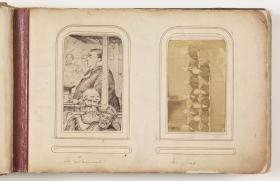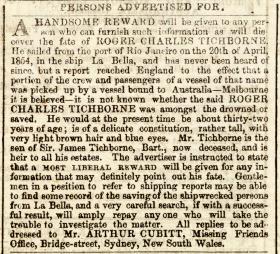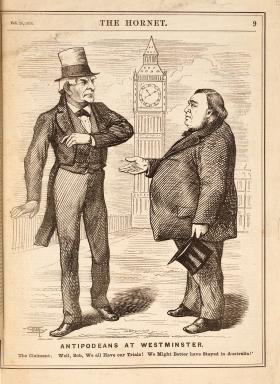Crime stories have always captured the public’s imagination – usually, the more gruesome the better. But every now and then, a story comes along that isn’t at all bloodthirsty, but is so unlikely that it’s stranger (and more interesting) than fiction.
The Tichborne Case is one such example – it has everything; a shipwreck, a massive reward, an English inheritance, a grieving mother and an outlandish butcher from Wagga Wagga. Although it happened two centuries ago, it is still a source of inspiration to artists – books have been written, films made, and plays performed, such as Who You Are, by Nick Backstrom, which premiered in Melbourne in 2014.

The Tichbornes were an extremely wealthy and titled family, with land in the English county of Hampshire. Roger Charles Tichborne, whose uncle was the 8th baronet, was born in Paris in 1829, and spoke English with a strong French accent.
When Roger was 20, he joined the 6th Dragoon Guards in Dublin, but sold his commission three years later in 1852. In 1853, his father became the 9th baronet after his two elder brothers died. That same year, Roger, now heir to the title and fortune, went to South America.
In 1854, he set sail for New York on board the Bella, but less than a week later, the Bella was lost at sea. Roger was declared dead in 1855.
When Roger’s father died in 1862, the Tichborne baronetcy was passed to Roger’s younger brother Alfred. Alfred died only four years later, just months before the birth of his son, who then inherited the title in 1866.
While Alfred was still alive, Roger’s mother, Lady Henriette Tichborne, refused to believe that Roger had drowned; there was some talk that a number of passengers and crew had survived the shipwreck and were picked up by a ship bound for Melbourne. She put out enquiries all over the world, including a reward notice in the Sydney Morning Herald, to try to find her son’s whereabouts.
In November 1865, William Gibbes, an Australian solicitor, wrote to Lady Tichborne saying he’d heard from someone claiming to be her son. The man was a butcher from Wagga Wagga who went by the name of Tom Castro. He was larger than Sir Roger, had lighter hair, spoke no French, and didn’t have a French accent, but this didn’t bother Lady Tichborne – she hadn’t seen her son for more than 10 years, and anything could have happened in this time. She sent for Castro, who arrived in London in December 1866.
Castro visited the family estates and met various people who had known Sir Roger. He managed to acquire some powerful allies, including the Tichbornes’ solicitor, Edward Hopkins, and Andrew Bogle, a servant of Sir Roger’s uncle.
A few weeks later, he went to France to meet Lady Tichborne. It didn’t take much to convince her that this was her son back from the dead. A number of other family members also welcomed him back into the fold. Lady Tichborne set the Wagga Wagga butcher up in England, and gave him plenty of money to live on. By spending time with the family and picking their brains, he managed to thoroughly research Sir Roger’s life and maintain the deception, at least as far as some people were concerned.
Others were not so convinced. They discovered, through an agent in Australia, that Tom Castro was, in fact, Arthur Orton, who had been born in London. He made his way to Australia, but jumped ship for a while and spent time in Chile – as he’d actually been in South America, he was able to talk very convincingly to Lady Tichborne about it.
One serious mistake Orton made was to contact his real family in Wapping, East London, when he arrived back in England – something the sceptical members of the Tichborne family later discovered.
Even after Lady Tichborne died in 1868, Orton kept up the pretence, as he’d run up large debts that needed to be paid off. No longer having to worry about what Lady Tichborne thought, certain members of the family took him to court over his claim. This became one of the most famous legal cases of the nineteenth century, providing an enormous amount of entertainment to the general public, with the population divided into supporters and sceptics.
The first trial lasted nearly a year, from 11 May 1871 to 5 March 1872. Tichborne v. Lushington was a civil trial to establish Orton’s claim to the Tichborne inheritance, and to eject the tenant, Colonel Lushington, from the family estate. Almost 100 people spoke in Orton’s defence, but the main stumbling block in his story was his inability to speak French which, of course, Sir Roger spoke fluently.
Arthur Orton’s perjury trial, Regina v. Castro, began in 1873 and went on for more than six months. A jury had to be convinced that Orton’s claim to be Sir Roger Tichborne was false. They didn’t need much convincing – in February 1874, he was convicted of two counts of perjury and sentenced to 14 years’ hard labour by Lord Chief Justice Sir Alexander Cockburn.
Soon after the trial, Orton’s defence lawyer, Edward Kenealy, was elected to parliament and unsuccessfully tried to have the Tichborne case examined by a Royal Commission.
Orton served 10 years in prison, getting out in 1884. Although he confessed once, in 1895, to being an impostor, he later withdrew that. Life after jail was rough – without access to the Tichborne fortune, he lived in poverty and was destitute by the time of his death.
Strangely, after Orton died in London in 1898, he was officially acknowledged as Sir Roger Tichborne: his death certificate and coffin plate both bare this name. The London Daily Mail said:
"The Judges of the High Court were two years in determining that the living Tichborne was Orton. The Registrar of Births and Deaths determined in two minutes that the dead Orton was Tichborne."
Press reaction to the Tichborne case
The press had a field day with the Tichborne case – the whole thing was so unlikely that it made for a hilarious yarn, and one that the press could mercilessly send up.
The library has a significant collection of material relating to the case, including these three comics, numbered two, eight and nine in a humorous series called Clarke’s Whims and Oddities, published by H.G. Clarke & Co. in London’s Covent Garden. These little pamphlets folded out into a single sheet containing ‘a humorous poem, with 16 droll illustrations’, and were available in plain or coloured editions, for one penny or sixpence. The interest in the trial spawned thousands of similar cheap, popular publications, as well as broadside ballads.
Tichborne souvenirs
Part of the appeal of the Tichborne trial was that many members of the public saw it as a challenge to the dominance of the upper classes and enthusiastically supported Orton, who they liked for his humble accent and background. Others just considered the trial the most spectacular sport, to be discussed, analysed and laughed about.
It didn’t matter what side they were on, interest didn’t wain in the story and quite a market built up for souvenirs, including photographs of the main participants. The library has an album that contains small photographs of Arthur Orton, the real Sir Roger Tichborne, members of the jury, barristers and judges associated with the case, plus pictures of various other members of the Orton and Tichborne families.
These cartes-de-visite photographs were mainly taken by the London Stereoscopic & Photographic Company. (Cartes-de-visite were relatively inexpensive and were usually taken by people to hand out to family members and friends.)
Also included in the album is a post-mortem photograph of bushranger Daniel ‘Mad Dog’ Morgan, who had nothing at all to do with the Tichborne case, but both he and Orton had a Wagga Wagga connection. The Tichborne case put Wagga Wagga on the international map – the writer Mark Twain was so intrigued by the case that he included the town on his Australian itinerary when he visited in 1895.
Celebrity life
It didn’t matter what happened with the Tichborne case – Arthur Orton made his name anyway, and until he was thrown into jail, was treated like a celebrity. He was often asked to appear at theatres and meetings, and was an honoured guest at shooting parties and all sorts of other gatherings. There was even a wax model of him at Madame Tussaud’s in London – he supplied the clothing.


